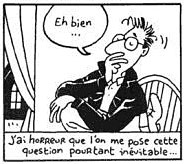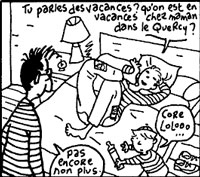>> Beyond Borders: Mondo Loco
>> Beyond Borders: Every Picture Tells A Story
More...

Creative process is a bitch.
Yeah, you heard me. It doesn't matter if you're talented or not, or if you're focused or not; if words don't want to come out of your mind and straight to the keyboard, you're fucked. You know what you want to talk about, but you're damned if you can make any goddamn sense out of it and commit it to paper.
There's nothing more frustrating than drinking two gallons of coffee, smoking two fields of tobacco, and spending fifty six straight hours typing on-the-motherfucking-writing-zone and then, when looking back at what you've got, suddenly realising that all your hard work is nothing but amateurish babbling worthy of a steroid addicted chimpanzee. Or so you believe
 It's not until someone tells you how great they think your pieces are that you start waking up from self-doubt hell. And that is a good starting point for the fear-of-the-sycophant syndrome. Ah, the life of the tortured writer. But anyway, we are here to talk about comics. And today's piece comic is all about the creative processes behind making a comic. JOURNAL D'UN ALBUM by Philippe Dupuy and Charles Berberian.
It's not until someone tells you how great they think your pieces are that you start waking up from self-doubt hell. And that is a good starting point for the fear-of-the-sycophant syndrome. Ah, the life of the tortured writer. But anyway, we are here to talk about comics. And today's piece comic is all about the creative processes behind making a comic. JOURNAL D'UN ALBUM by Philippe Dupuy and Charles Berberian.
Dupuy and Berberian are a rara avis in the comic business. They work together, but not as a writer/artist combo. They really work together. They both write, they both draw, and they do it on the same pages. Weird, isn't it? But they explain how they really do it inside the book. Ironic, since this is a book they did each on their own. Or something. I'll explain it later.
Dupuy and Berberian met at the ranks of the fanzine PLG, a twenty year old publication where many big names of the French industry have made their debut. They started to collaborate in 1984 on a series later compiled in a volume entitled GRAINE DE VOYOUS, this time for another independent mainstay, the magazine Fluide Glacial, running fiercely independent since 1975.
But they didn't hit their first strike until completing the first volume of LE JOURNAL D'HENRIETTE, a chronicle of the loves and pities of a teenager called Henriette that was to become their longest running and most famous series along with MISTER JEAN. Around the same time, they started compiling albums of their illustrations, beginning with LE PETITE PEINTRE, and continuing with volumes dedicated to cities such as Lisbon and New York. However, it was MISTER JEAN, an incredibly funny series about a thirtysomething single man and his life in Paris, that first brought them fame and success, and garnered them a number of awards.
 During the conception of the third volume of MISTER JEAN, both creators decided to start a journal, chronicling his struggles with the creative process necessary to putting together the comic. However, while they worked together on MISTER JEAN and all their collaborations, they agreed to produce their journal pages separately. The end result shows both collaborators in crisis.
During the conception of the third volume of MISTER JEAN, both creators decided to start a journal, chronicling his struggles with the creative process necessary to putting together the comic. However, while they worked together on MISTER JEAN and all their collaborations, they agreed to produce their journal pages separately. The end result shows both collaborators in crisis.
Berberian's side is somewhat lighter. He had many of the usual midlife troubles; still clinging to his boyhood possessions, still doubting of his future as a bande desinée creator. Berberian tells us a couple anecdotes about his career as a cartoonist, and we get to know the author's creative process and how they met each other. Later he moves into more bittersweet territory as he talks about his feelings on growing old, though it's territory we've seen covered before in Lewis Trondheim's NIMROD. Reading this first part of the graphic novel leaves you with a warm feeling, of childhood memories and anecdotal recollections. Then along comes Dupuy to shit on the cake.
Dupuy was having a really difficult time as he worked on the journal. He was jealous of his partner, he was temporarily separated from his partner and their son, his mother had just died, he had to live and work in a tiny study with a psychotic neighbour constantly yelling at him... in short, everything seemed to be falling apart, and his half of the journal shows us just how suddenly his life seemed to spiral away from him.
This is where the book stops being just another story about a creator's struggles. This is the story of a creator self destructing right there in front of you, losing his grip on the work and the book. For Dupuy, the creative process seems to lose any meaning as his life falls apart around him.
 The magnificence of this book is that somehow, despite all their troubles, the authors just kept making the journal, and the reader can see Dupuy losing his confidence, his family, his hope, and then coming back, fighting his demons and attempting to rebuild his life.
The magnificence of this book is that somehow, despite all their troubles, the authors just kept making the journal, and the reader can see Dupuy losing his confidence, his family, his hope, and then coming back, fighting his demons and attempting to rebuild his life.
There are six particularly chilling panels, in which Dupuy receives the news of his mother's death. You turn the page, and there are six mute panels and a single phrase: "six panels for a life"; six panels to describe his life with his mother. And it all makes sense. The pain flows from the page and soaks into the reader. You're there with Dupuy as he says fuck the world, fuck the work, fuck my pain, because nothing really matters anymore, and everything is broken. But as Dupuy continues, things to start to make sense again. He shakes off his heartache, gets his act together, and goes back to his family and to Berberian.
The rest of the journal changes the pace as it moves away from the authors' struggles to get the book done, and centre instead on a different set of problems: the pains to get the book published. Dupuy and Berberian go to Humanoids to release the album, and they recount the many, many misadventures that occurred on the road to the book's release, from the search for a new colourist to the near bankruptcy of Humanoids. The book ends with the publishing of both the third volume of Mister Jean and the journal, with the creators reaching a new stage in their lives; a period of great success, as MISTER JEAN, HENRIETTE and JOURNAL D'UN ALBUM are all acclaimed as some of the best works published in France in the nineties.
Every creator or aspiring creator should read this book. Several times. Every time you struggle with the shadow of an idea stuck in your head, clouded by everyday life, you should turn to these pages. And in particular, those six panels, within which lie the answers to any number of questions you might have.
Most of the works of Dupuy and Berberian are unavailable in the English language, but Highwater Books has plans to publish JOURNAL D'UN ALBUM in English under the title I PITY YOU some time in the coming year. For more information on the creators, visit their website at www.duber.net. But only if you speak French.

This article is Ideological Freeware. The author grants permission for its reproduction and redistribution by private individuals on condition that the author and source of the article are clearly shown, no charge is made, and the whole article is reproduced intact, including this notice.


